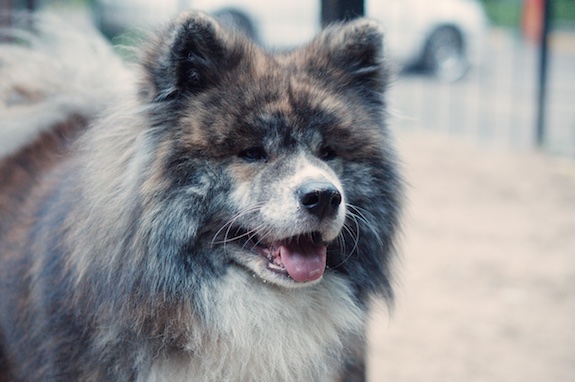
Inasmuch as we like to share information about accepted breeds in all their forms, we’re also about sharing information about aspects of a breed that may not be acceptable by any breed club or registry. There are so many claims being made about “rare” and “unusual” dogs leveled at potential – and unsuspecting – owners, that we find it important to share what we learn in the spirit of “buyer beware.”
Enter the Long Coated Akita, aka the Woolie or Silkie.
The AKC breed standard reads, “Triple coated with the outer coat consisting of coarse, straight guard hairs that stand off the body. The two inner coats are under coats. One is thicker and somewhat soft, generally matching the coat color. The second is closest to the skin and is generally thicker and wool-like in texture and can be a different color than the guard coat. Tail guard hairs are much longer and fuller. The Japanese Akitainu should be presented in a natural state without trimming or shaping. Fault – Short, flat coat. Disqualification – Long coat”
A long coated Akita may have a coat that ranges from a slight feathering to a huge wooly coat that can reach to the dog’s feet. The coat will feel softer, woolier, and/or silkier than the short coat because of longer guard hairs and a very dense undercoat. There isn’t necessarily more hair on the long coat, just longer hair. It is not recognized by the AKC, and judges consider it a blatant fault. Indeed, some judges can go a lifetime and never even see one for obvious reasons. It is a recessive gene and seen so infrequently in public that most people aren’t even aware that they exist.
How did the breed even come this way?
The Long Coated Akita is thought by some to be a throwback to a dog called the Karafuto Ken, also known as the Sakhalin Husky. These dogs were introduced into Akita bloodlines many years ago (possibly in the 1900s) by Japanese breeders with the purpose of increasing coat density to endure the frigid climate of northern prefectures.
Our sense is that there have been a few petitions to get the Long-coated Akita recognized as a classification of its own, but as you can imagine, there is a lot of heated debate about the subject, and not just because of coat length. Breeders have come to experience that long coats seem to be associated with a large size, heavier bone, and bigger heads. They also find that long coated Akitas seem, on average, to be more tractable, friendly and gentle. This is of little help to the potential buyer who wants to show their Akita. Our suggestion to anyone considering any dog touted as being “rare” or uncommon in some way is to read its standard (whatever its breed) first!
Image: Long Coated Akita photographed by Spalf is shared under the Creative Commons Attribution-Share Alike 4.0 International license.
